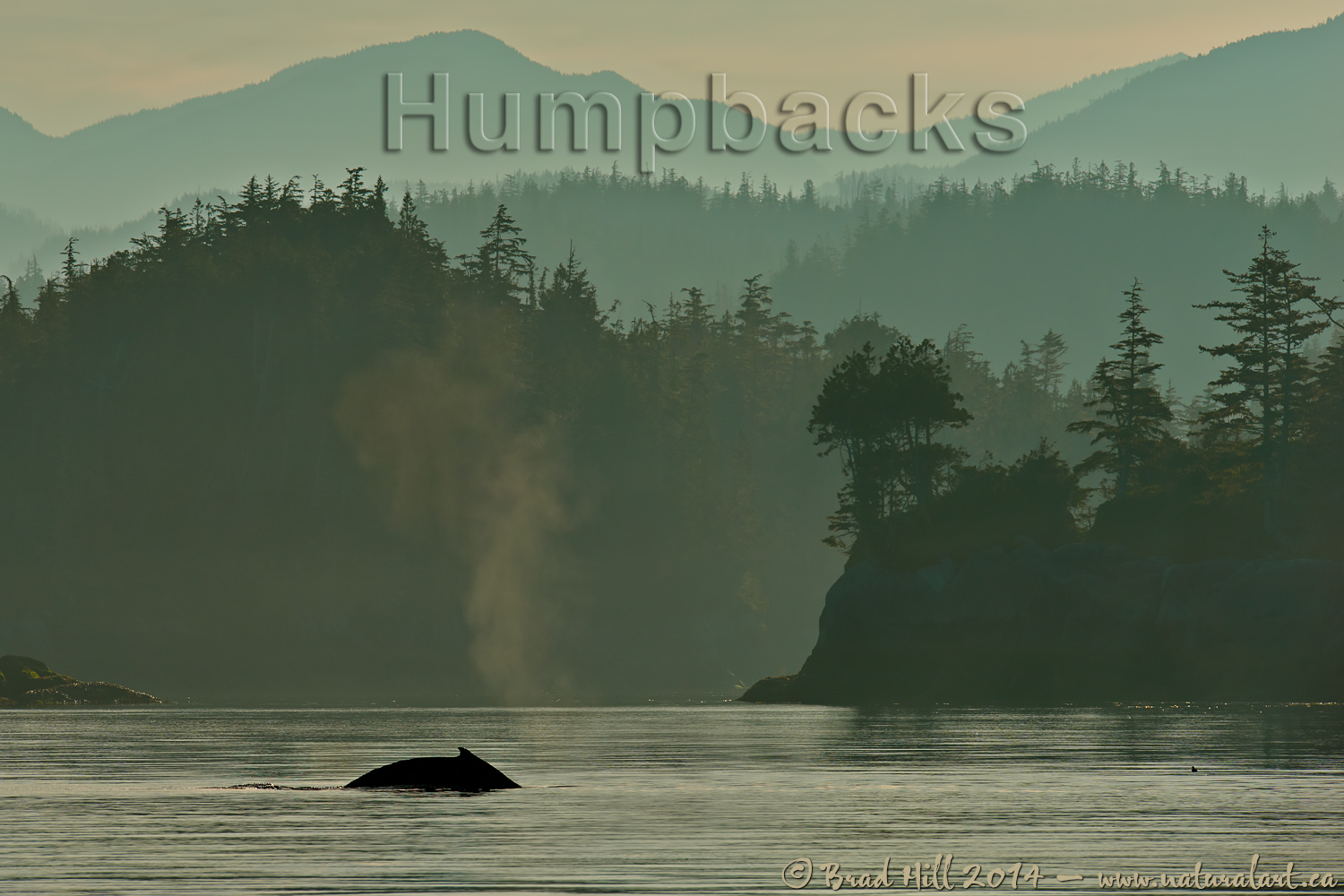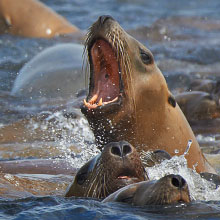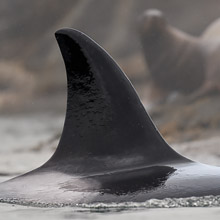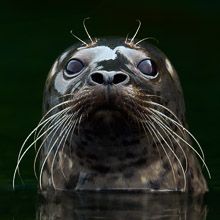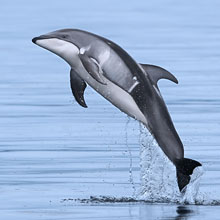Availability: Undetermined - Enquiries?
In the Field
One Whale of a Morning. Johnstone Strait Region, northern Vancouver Island, BC, Canada. August 10, 2014.
View additional Humpback Whale images beginning here: Humpback Whales
What's that old saying? "Good things come to those who wait?" Well...this image came after a lot of waiting and, in this case, after a few hours of sitting in pea-soup fog while we could hear humpbacks surfacing and blowing but could see absolutely nothing. Fortunately for us the fog did eventually did lift and gave us a few moments of magical, early-morning lighting. Even more fortunately we had a very cooperative humpback whale (and a very competent skipper who knows exactly how I like to align my subjects in front of stunning backdrops - thanks Chris!) who chose to surface, blow, and then roll down back under the water in exact position I would have placed it in my "perfect world".
I've said it many times before, but one of the toughest things in wildlife photography is avoiding becoming so completely enthralled by your subject where you can't see the "full scene". In this shot it would have been easy to see "just" the whale and the backlit steam drifting upwards after it blew and not notice the beautiful layered ridges in the background (that so conveniently went from dark tones in the closest treed "ridge" throughout to very light pastels in the more distant background). I find this "not seeing the full forest for the dramatic tree (your subject)" is always something to be on the lookout for, but even more so if you happen to be hand-holding your camera and lens - it seems that when doing so it is so easy to let your eye "rest" on the subject (especially if it's moving) and not study the rest of the frame. One has to actively think "study the entire frame" while looking through the viewfinder in order to avoid the tendency to look only at the subject.
The toughest aspect of capturing this image in the field was positioning the whale so low in the frame and ensuring it was sharply in focus (this is only a very small crop, and the subject WAS this low in the viewfinder - and outside the zone the AF brackets can move to). To ensure maximum sharpness on the subject and still frame the scene the way I wanted I had to use the lowest focus brackets in my viewfinder, focus on the subject, lock the focus, and then quickly recompose the scene to include the distant ridges AND a sliver of sky in the frame. Why use the lowest AF brackets in the frame (rather than having the bracket at the centrepoint)? In using the lowest brackets I minimized the amount of recomposing needed to frame the image as seen above. In this case minimizing the recomposing time was critical to catch the moving whale exactly at the point in its dive that I wanted to. Little thing? Yep. But an important little thing!
• One Whale of a Morning: Download 2400 pixel image (JPEG: 1.2 MB)
ADDITIONAL NOTES:
NOTE 1: This image - in all resolutions - is protected by copyright. I'm fine with personal uses of it (including use as desktop backgrounds or screensavers on your own computer), but unauthorized commercial use of the image is prohibited by law. Thanks in advance for respecting my copyright!
NOTE 2: This image was captured during my "Humpbacks, Orcas, Sea Lions & More!" photo tour in the summer of 2014. Each year I offer trips into two different parts of the Great Bear Rainforest as well as one to photograph aquatic mammals and oceanscapes near the northern tip of Vancouver Island. And, in selected years, I also offer photo tours to locations to capture other highly sought-after subjects, such as various boreal owl species and wildlife of Canada's Arctic. Details about these trips can be found on the Photo Tours page of this website.
NOTE 3: Like all wildlife photographs on this website, this image was captured following the strict ethical guidelines described in The Wildlife FIRST! Principles of Photographer Conduct. I encourage all wildlife photographers to always put the welfare of their subjects above the value of their photographs.
Behind the Camera
One Whale of a Morning. northern Vancouver Island, BC, Canada. August 10, 2014.
Digital Capture; Compressed RAW (NEF) 14-bit format; ISO 250.
Nikon D800e paired with Nikkor AF-S 400mm f2.8G VR - hand-held from sailboat. VR on in Normal mode.
1/800s @ f11; -0.33 stop compensation from "recommended" matrix-metered exposure setting.
At the Computer
One Whale of a Morning. northern Vancouver Island, BC, Canada. August 10, 2014.
RAW Conversion to 16-bit TIFF, including first-pass/capture sharpening using Phase One's Capture One Pro. Two raw variants (different versions of a single raw capture) processed, differing by a total of 1 stop in exposure. Adjustments made during raw conversion included tweaks to white balance, levels (slightly redefining both the black and white points), clarity, and a small amount of highlight suppression.
Further digital corrections on resulting 16-bit TIFF files using Adobe's Photoshop CC 2014 and Light Crafts Lightzone. Photoshop adjustments included compositing (blending) of the two output files from the raw converter, additional minor exposure and contrast tweaks, and selective sharpening for web output. Final tweaking of tones performed using LightZone's "tonemapper" and zonemapper tools.
Conservation
One Whale of a Morning. northern Vancouver Island, BC, Canada. August 10, 2014.
Ten percent of the revenue generated by this image will be donated to Raincoast*.
Species Status in Canada**: Threatened - North Pacific population (May 2003).
Humpback Whales (Megaptera novaeagnliae) are active, acrobatic whales that can throw themselves completely clear of the water (a behaviour known as breaching) and will swim on their backs with both flippers in the air. Humpbacks are large (up to 14m - or 46 feet - in length and 40 tonnes in weight) and with huge flippers.
Humpbacks are found in tropical, temperate, and sub-polar waters around the world. They are found on both the east and west coasts of North America. The North Pacific population has been estimated at between 6,000 and 8,000 individuals, but only a few hundred of these are found in the waters off the coast of British Columbia.
While Humpbacks are recovering from the damage done to their populations by commercial fishing, the are still subject to a variety of threats from human activities, including becoming entangled in fishing nets, noise and chemical pollution and habitat destruction.
*The Raincoast Conservation Society (and Foundation) is an effective and efficient organization that has been fighting for protection of this unique habitat. If you are looking for a meaningful way to contribute to the conservation of this amazing ecosystem, Raincoast will provide maximal "bang" for your conservation dollars.
**as determined by COSEWIC: The Committee on the Status of Endangered Wildlife in Canada












